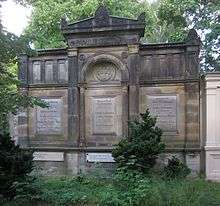Maximilian Fretter-Pico
| Maximilian Fretter-Pico | |
|---|---|
| Born |
6 February 1892 Karlsruhe, German Empire |
| Died |
4 April 1984 (aged 92) Kreuth, West Germany |
| Allegiance |
|
| Service/branch | Heer |
| Years of service | 1910–45 |
| Rank | General of the Artillery |
| Commands held | XXX. Armeekorps |
| Battles/wars | World War II |
| Awards | Knight's Cross of the Iron Cross with Oak Leaves |
| Relations | Otto Fretter-Pico (brother) |
Maximilian Fretter-Pico (6 February 1892 – 4 April 1984) was a German general during World War II. He was a recipient of the Knight's Cross of the Iron Cross with Oak Leaves of Nazi Germany.
Fretter-Pico was born in Karlsruhe, Baden-Württemberg, Germany. Fretter-Pico entered service in 1910 with the Imperial German Army and served in World War I. During the inter-war years, he remained in the German military; in 1938, he was posted to Turkey as a military attaché. During Operation Barbarossa, the 1941 invasion of the Soviet Union, Fretter-Pico commanded of the 97th Jäger Division in Army Group South. On 27 December 1941, he was given command of XXX Corps, which participated in the Battle of Sevastopol in southern Ukraine. Fretter-Pico was promoted to a full general in June 1942. He remained the commanding officer of XXX Corps until mid-1944, and then commanded the 6th Army for the remainder of the year. In March 1945, he was given command of IX Corps, an under-strength reserve unit. He surrendered to the American forces on 22 April 1945 and was interned until 1947. Fretter-Pico died at Bad Wiessee in Bavaria, Germany.
Awards

- Iron Cross (1914) 2nd Class (12 October 1914) & 1st Class (23 December 1916)[1]
- Knight's Cross 2nd Class of the Order of the Zähringer Lion with Swords (10 October 1914)[1]
- Hanseatic Cross of Hamburg (20 January 1918)[1]
- Wound Badge in Black (June 1918)[1]
- Clasp to the Iron Cross (1939) 2nd Class (31 October 1939) & 1st Class (16 June 1940)[1]
- West Wall Medal (22 November 1940)[1]
- German Cross in Gold on 19 September 1942 as General der Artillerie and commanding general of the XXX. Armeekorps[2]
- Knight's Cross of the Iron Cross with Oak Leaves
- Knight's Cross on 26 December 1941 as Generalmajor and commander of the 97. Infanterie-Division[3]
- 368th Oak leaves on 16 January 1944 as General der Artillerie and commanding general of the XXX. Armeekorps[3]
- Mentioned in the Wehrmachtbericht on 30 October 1944
References
Citations
Bibliography
- Patzwall, Klaus D.; Scherzer, Veit (2001). Das Deutsche Kreuz 1941 – 1945 Geschichte und Inhaber Band II [The German Cross 1941 – 1945 History and Recipients Volume 2] (in German). Norderstedt, Germany: Verlag Klaus D. Patzwall. ISBN 978-3-931533-45-8.
- Scherzer, Veit (2007). Die Ritterkreuzträger 1939–1945 Die Inhaber des Ritterkreuzes des Eisernen Kreuzes 1939 von Heer, Luftwaffe, Kriegsmarine, Waffen-SS, Volkssturm sowie mit Deutschland verbündeter Streitkräfte nach den Unterlagen des Bundesarchives [The Knight's Cross Bearers 1939–1945 The Holders of the Knight's Cross of the Iron Cross 1939 by Army, Air Force, Navy, Waffen-SS, Volkssturm and Allied Forces with Germany According to the Documents of the Federal Archives] (in German). Jena, Germany: Scherzers Miltaer-Verlag. ISBN 978-3-938845-17-2.
- Wegmann, Günter (2010). Die Ritterkreuzträger der Deutschen Wehrmacht 1939–1945 Teil III: Infanterie Band 7: Fl–Fu [The Knight's Cross Bearers of the German Wehrmacht 1939–1945 Part III: Infantry Volume 7: Fl–Fu] (in German). Osnabrück, Germany: Biblio-Verlag. ISBN 978-3-7648-2380-1.
- Die Wehrmachtberichte 1939-1945 Band 3, 1. Januar 1944 bis 9. Mai 1945 [The Wehrmacht Reports 1939–1945 Volume 3, 1 January 1944 to 9 May 1945] (in German). München, Germany: Deutscher Taschenbuch Verlag GmbH & Co. KG. 1985. ISBN 978-3-423-05944-2.
| Military offices | ||
|---|---|---|
| Preceded by General der Infanterie Sigismund von Förster |
Commander of 97. Infanterie-Division 15 April 1941 – 27 December 1941 |
Succeeded by Generalleutnant Ernst Rupp |
| Preceded by Generaloberst Hans von Salmuth |
Commander of XXX. Armeekorps 27 December 1941 – 4 July 1944 |
Succeeded by General der Kavallerie Philipp Kleffel |
| Preceded by General Maximilian de Angelis |
Commander of 6. Armee 17 July 1944 – 22 December 1944 |
Succeeded by General Hermann Balck |
